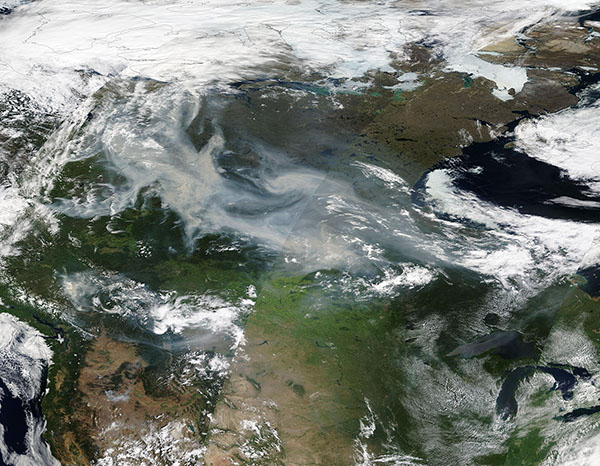Images
July 22, 2024 - Heavy Smoke over Canada
Tweet
Smoke continued to blanket Canada as North American boreal forests burned in mid-July 2024.
The Moderate Resolution Imaging Spectroradiometer on NASA’s Terra satellite acquired this true-color image of thick gray smoke pouring across Canada on July 18. From west to east, the long gray plume can be seen covering parts of Northwest Territories, Alberta, Saskatchewan, and Manitoba. It mingles with the cloud across Hudson Bay while a gray tendril extends over Lake Superior to darken skies in the U.S. states of Wisconsin and Minnesota.
The 2024 Canadian wildfire season started early, with fires cropping up in May in British Columbia. On July 19, the Weather Channel reported that 88 new fires had been reported in British Columbia in the previous 24 hours, triggered by extreme heat, dry conditions, and dry lightning strikes unaccompanied by rain. One wildfire of note sparked in that province on July 20 and expanded to 1,350 hectares by the next day. Because the Antler Creek Fire is displaying extreme fire behavior, it has triggered evacuations of Barkersville and the district of Wells on July 21, according to local media reports.
While most of the current wildfires are burning in British Columbia and Alberta, the rest of the western North American boreal forest also hosts hundreds of wildfires. They are reported across Northwest Territories, Saskatchewan, Yukon, and in the U.S. state of Alaska.
Extreme smoke events naturally follow widespread fires. The Copernicus Atmosphere Monitoring Service (CAMS) estimates that the June-July monthly total carbon emissions (up to 15 July for 2024) from wildfires in British Columbia amounts to 11.08 megatons of carbon and 13.23 megatonnes for Alberta. The 2024 emissions for the period are already amongst the highest June-July totals in the CAMS GFAS data set, although well below the emissions from this period in the record year of 2023.
Image Facts
Satellite:
Terra
Date Acquired: 7/18/2024
Resolutions:
1km (4 MB),
Bands Used: 1,4,3
Image Credit:
MODIS Land Rapid Response Team, NASA GSFC
Tweet
Smoke continued to blanket Canada as North American boreal forests burned in mid-July 2024.
The Moderate Resolution Imaging Spectroradiometer on NASA’s Terra satellite acquired this true-color image of thick gray smoke pouring across Canada on July 18. From west to east, the long gray plume can be seen covering parts of Northwest Territories, Alberta, Saskatchewan, and Manitoba. It mingles with the cloud across Hudson Bay while a gray tendril extends over Lake Superior to darken skies in the U.S. states of Wisconsin and Minnesota.
The 2024 Canadian wildfire season started early, with fires cropping up in May in British Columbia. On July 19, the Weather Channel reported that 88 new fires had been reported in British Columbia in the previous 24 hours, triggered by extreme heat, dry conditions, and dry lightning strikes unaccompanied by rain. One wildfire of note sparked in that province on July 20 and expanded to 1,350 hectares by the next day. Because the Antler Creek Fire is displaying extreme fire behavior, it has triggered evacuations of Barkersville and the district of Wells on July 21, according to local media reports.
While most of the current wildfires are burning in British Columbia and Alberta, the rest of the western North American boreal forest also hosts hundreds of wildfires. They are reported across Northwest Territories, Saskatchewan, Yukon, and in the U.S. state of Alaska.
Extreme smoke events naturally follow widespread fires. The Copernicus Atmosphere Monitoring Service (CAMS) estimates that the June-July monthly total carbon emissions (up to 15 July for 2024) from wildfires in British Columbia amounts to 11.08 megatons of carbon and 13.23 megatonnes for Alberta. The 2024 emissions for the period are already amongst the highest June-July totals in the CAMS GFAS data set, although well below the emissions from this period in the record year of 2023.
Image Facts
Satellite:
Terra
Date Acquired: 7/18/2024
Resolutions:
1km (4 MB),
Bands Used: 1,4,3
Image Credit:
MODIS Land Rapid Response Team, NASA GSFC




